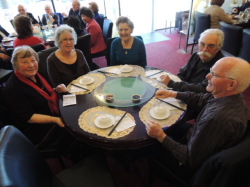OUR NEXT MEETING WILL BE:
DATE: Sunday 22 JULY 2012
TIME: 12:30 P.M.
VENUE: WEILIN’S NOODLES HOUSE for LUNCH – 1148 Tutanekai St (lake end)

The Committee decided it was time for a break from the usual and enjoy a lunch out. We have heard good things about this small Restaurant. It is not flash but good food, especially noted for their steam buns. It is necessary for you to RSVP either to Norma ph 348-2110 or email <[email protected]> or Brenda ph 332-5731 or email [email protected] before Tuesday 17 July. Limited seating (approx. 25)
The menu will consist of 2 soups: Chicken Noodle and Vegetable Curry; 3 types of steam buns: Beef and Celery, Pork and Chives and Vegetable; Chicken Fried Rice and of course green tea. The cost will be $ 16. per person.
NEXT MEETING
We will be back at the Arts Village and hopefully Brenda and Cliff will tell us about their China adventures.
FOUND
At last months meeting I ended up with someones very nice bowel which was new and still had its price sticker on it. My bowel was missing. I have ended up with the better deal ! Please let me know if you have ended up with the wrong bowel and we can make an exchange.
NATIONAL NEWS
RAFFLE TICKETS
These tickets are still available at $5. per ticket with $1 staying in our branch. The winning ticket – return airfare to Shanghai for 2 – includes domestic airfare connections. Travel is between 1 October 2012 September 2013 (cannot be taken between 1 Dec. – 29 Feb.). To be drawn on 1 Oct 2012. Second prize set of stoneware and third is a wall hanging. The tickets will be available at our July meeting or contact either Norma Millard ph 348-2110 or Brenda Lee ph 332-5731. There is not much time to be in to win. We will be returning our unsold tickets at the end of August.
NEW FUND FOR CHINA FRIENDSHIP EXCHANGES
One of China’s most senior politicians has announced a one million RMB (NZ$200,000) contribution from China to a new fund which “will inherit and develop the spirit of Mr Alley and continue the great cause he started”. Mr Liao Hui, President of the China-Oceania Friendship Association, and Vice- Chairman of the powerful Chinese People’s Political Consultative Conference (CPPCC). He told the Auckland gathering that the New Zealand writer, educator and activist Rewi Alley who lived in China from 1927 to his death in 1987, had not only devoted himself to China’s reforms, he contributed much to China New Zealand friendship.
NZCFS President Eric Livingstone, the surprise announcement by Mr Liao Hui at Conference of the creation of the Rewi Alley Exchange & Friendship Fund was a major highlight for our Society’s celebrations of our sixty years since our founding.
Today, few New Zealanders would question the need to have a friendly, trusting and productive relationship with China. But it was quite a different story in 1952, when the Cold War dominated New Zealand’s view of the world. It was a brave and innovative move to establish the New Zealand China Friendship Society in such an environment, at odds with the dominant political viewpoint.
What might the future relationship between our countries look like? It will take widespread “China literacy” to ensure New Zealand continues to make the most of the friendship we enjoy with the People’s Republic of China today. The New Zealand China Friendship Society has a important role to play in that by continuing to provide the visionary leadership it has shown in the past 60 years
Hon Philip Burdon Patron, New Zealand China Friendship Society Chairman, Asia New Zealand Foundation
And what of that future?
In the future that is unfolding, the activities of this Society will become both more important and harder. The latter because there will be so many more actors involved with China, across the whole spectrum of New Zealand life; the former because it has never been more essential to have a good understanding of China and to communicate that within New Zealand.
John McKinnon
Jenny Christensen’s thoughts after the recent Photographers Tour A NEW ZEALAND PERSPECTIVE OF CHINA
The official language of China is based on the dialect spoken in Beijing. Outside China, it is known as Mandarin Chinese. The tonal “common tongue” in Shanghai is not a language that caresses the ear. In a country boasting 20% of Planet Earth’s population it is not surprising that it is shouted and sometimes screamed. It’s a “look at me, listen to me” language.
Coming to terms with the distribution of 1.3 billion people and the realisation that at any one time more people than the entire population of New Zealand are on holiday was a challenge. Our guides spoke in numbers. Twenty thousand Chinese tourists visit Fenghuang each day, seventy million Chinese holiday makers visit Hangzhou each year, the current population of Shanghai is 23 million. This translates into flag waving guides shouting over each other to ensure their charges, identified by a common item of clothing – a red hat, yellow raincoats – could hear their stories. It meant a three hour queue to access the forest park at Zhangjiajie and body parts protruding through the margins of our photographs. It meant sharing an 8 person chair lift with 4 Chinese girls each carrying out a loud conversation on their cell phones.
There are too many Ethnic minorities, too many geographic regions that define life style (China stretches over 50 degrees of latitude), simply too many people to stereotype and an almost impossible task to choose ten photographic images illustrating a single New Zealander’s perspective of China.
China is an ancient country with a record of human habitation stretching back to 8000 BC. We visited Yangshao and learnt that the people who lived there between 5000-3000 BC produced earthenware pottery. This is a difficult concept for a New Zealander to grasp considering the time frame of human activity in our own country. We visited people living in 1000 year old homes, we marvelled at the technology used 2000 years ago leading to the creation of the Ling Canal linking Xing’an to Canton (Guangzhou) 400 km distant.
I see China today as a product of blending the ancient with the modern. My perception of the Chinese people is one of unstressed, happy people on holiday. The “open” faces do not match the “inscrutable Chinese” label of the 1950’s. I saw hard working people putting in long hours in the fields and in their small businesses. These people live their lives at street level and their premises double as a venue for card playing, socialising, drying the laundry, watching TV, enjoying a meal as well as the place where they bargained and negotiated deals.
Modern China is one huge construction site. Chosing to focus on infra structure development reduces the possible impact of Western financial problems. It creates employment and unites the country. Highway construction plus tunnels, bridges and enormous “sphagetti” junctions is linking the provinces and connecting rural communities to potential markets. Hundreds of thousands of apartments are being built. Apartment dwellers emerged as appreciative of the multiplicity of parks which are well utilised, especially in the evenings.
I gained the impression that the Chinese people were appreciative of the beauty of their natural surroundings. I am impressed by a country that creates attractive amenity plantings along the sides of highways and uses plantings to separate lanes. Parks have been created under some highway exchanges while elsewhere rural activities continue as the traffic moves sedately overhead. Large rocks encountered during highway construction are not destroyed by blasting but carefully extracted and given pride of place in a public park or at the entrance to large (important) buildings. Mature trees are transplanted so landscaping is almost instant. This respectful treatment of the natural environment is not surprising since 80% of the population is still involved in growing things – tea, rice, bamboo, 4 vegetables, flowers, grapes, rape, fruit….
55 different ethnic minorities live in China. We visited villages in remote hillside areas where the people were sustaining traditional customs through tourism, possibly to the detriment of farming practices. Two of our guides independently commented upon rice paddies and terraces left uncultivated because the people were singing, dancing, doing handcrafts, selling handcrafts, acting as porters or punting bamboo rafts on the rivers.
China is a young person’s country and the young are well dressed, well groomed, well versed in technology and appear to be supporting a boom in consumerism. Huge, attractively lit advertising billboards and electronic screens display images of luxury goods and luxury lifestyles using European models!
I felt there was an acceptance that the rapid growth and changing lifestyles create problems. The key to continued development lies in identifying the problems and finding solutions. We read whatever magazines and papers we could find and judging from the content innovative solutions are being found. For example: Shanghai will use shallow geothermal energy to heat and cool buildings by 2015, passenger trains running along the Qinghai-Tibet Railway are equipped with compressed garbage and sewerage collections systems and the railway stations use solar power for heating and lighting as do most modern homes and apartments.
“I did not tell half of what I saw, for I knew I would not be believed”. (Marco Polo)
Teacher wanted for Shandan Bailie School. Starting late February 2013 for one year. While the school only needs one teacher, this may suit a couple, with teaching positions in local middle schools an extra option. Please let other people who may be interested know of this unique opportunity to be a participant in one of the most longstanding relationships between China and New Zealand. contact Dave Bromwich [email protected]
Awards to mark the 60th Anniversary of NZCFS and the UN Year of the Cooperative
Since 2006 our projects in north west China to establish model coops has provided direct benefits to almost 10,000 households, with one coop now expanded to 1196 household members, and the benefit continues to multiply. Currently NZCFS projects have directly established 41 cooperatives in Zhangye/ Shandan, Gansu, and 8 in Shaanxi.
The members tell of the benefits of these cooperatives including:
Financial returns up by around 25%; Increased efficiency, improved community collaboration and harmony between households; Increased market security and confidence in planning leading to increased household ambition; Increased status and sense of well-being through successful self-help approaches.
NZCFS are commemorating the 2012 2012 UN Year of the Cooperative by making four Awards to cooperatives selected from our projects. Each coop who enters will outline their membership and any growth in numbers, what they consider to be the key advantages for their members and what areas they feel needs strengthening for their own coop. The Awards will be made at the banquet held at Shandan to commemorate our 60th and the Schools 70th anniversaries. The best in each province receives 5000rmb (NZ$1000) and 2500rmb to the runner-up. Promotion of the awards and the successful cooperatives will help to increase awareness of the benefits of our cooperative programme as we aim to reach a further 10,000 households.
If you would like to contribute contribute to these awards the costs are for the awards, plaques, and modest expenses to bring coop leaders to the presentation ceremonies. Assist us in our work to help rural households in China. Please make cheques out to NZCFS Projects and mail to 35 Breadalbane Road Havelock North 4130, or direct credit to 03 0658 0213133 025 with “Award” in reference line










